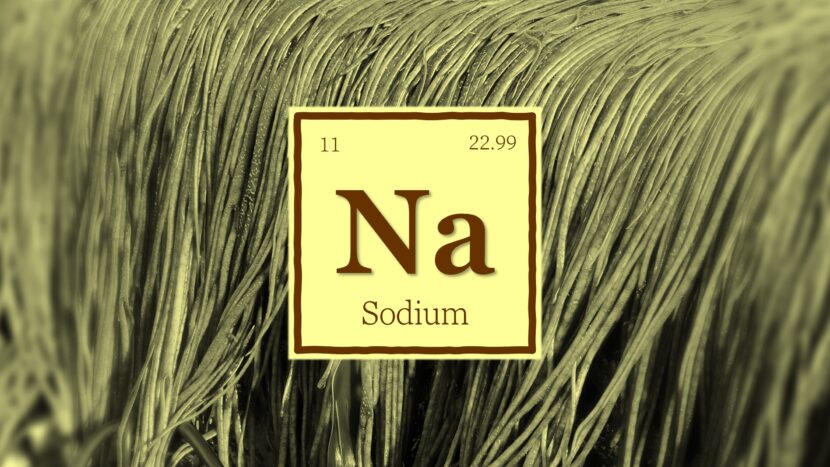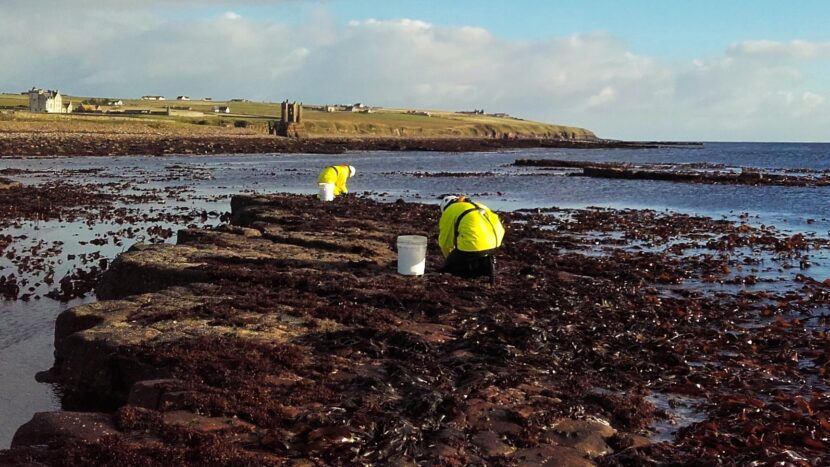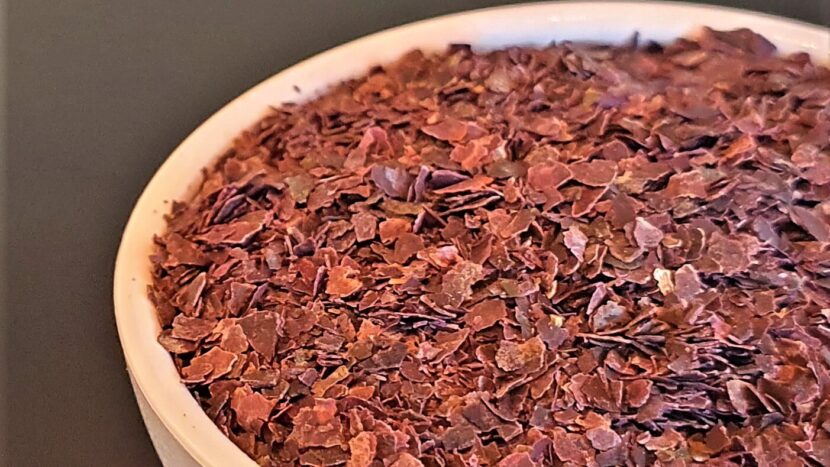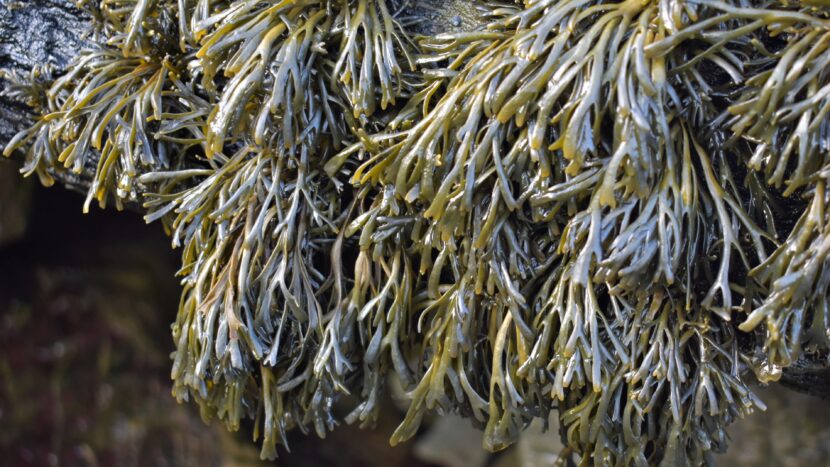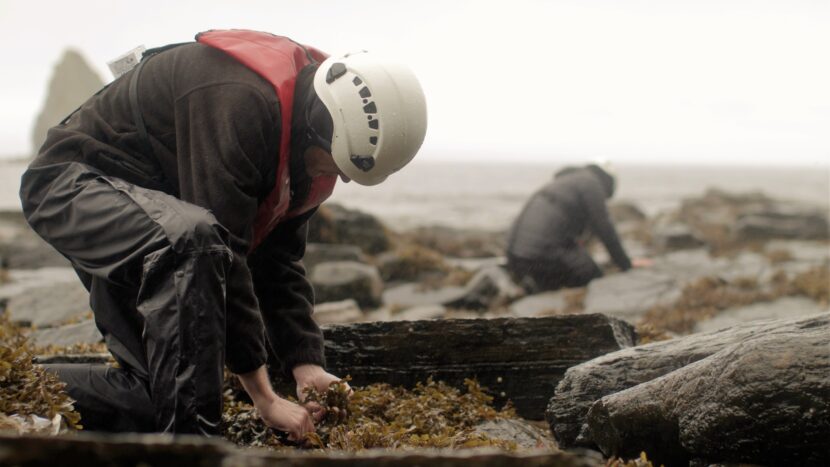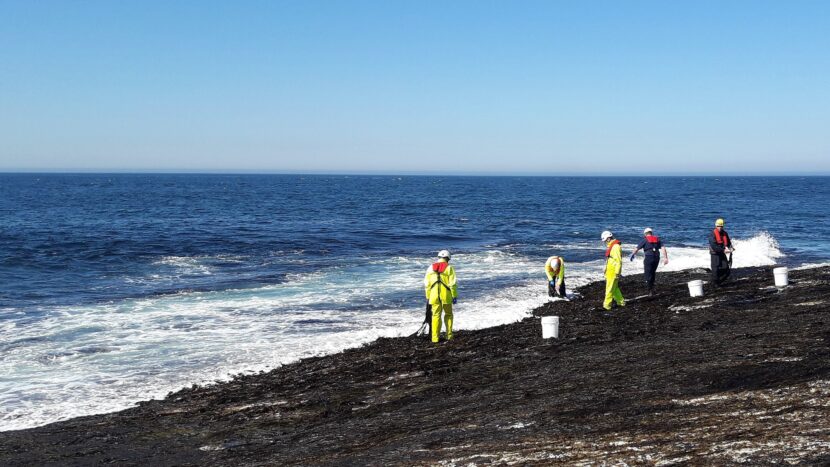Planning and executing a harvest

We are often asked how our seaweed is harvested. The short answer is ‘sustainably’, but there is a lot of work that goes into making this a reality. In this article, our Operations Coordinator David Lewis goes through the process step-by-step. He has been harvesting seaweed since 2016 and has an unrivalled knowledge of our Caithness harvest sites.

Operations Coordinator David Lewis on the foreshore harvesting wrack by hand
Advance planning around tides
The team starts thinking about the harvest many months in advance, because everything we do is driven by the tides. We review the heights of low water to work out when the stronger spring tides fall: these are our busiest weeks because we can reach species on the low shore. We tend to harvest less frequently during neap tides and so we will often plan maintenance and admin during these quieter periods. Check out our article on the importance of tides for our seaweed harvesting for more detail.
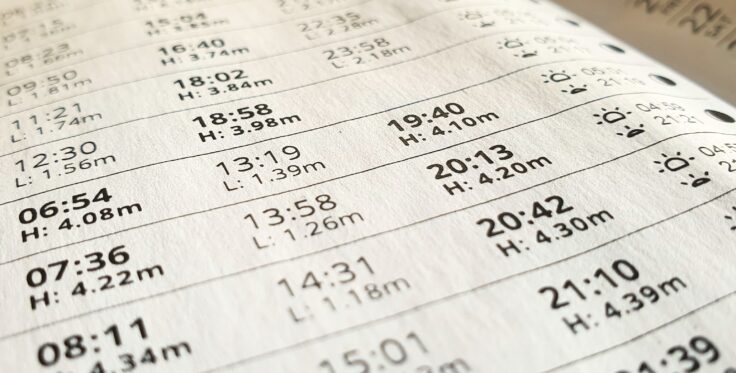
Our team carefully scrutinise tide tables to pinpoint the best opportunities for harvesting seaweed
The time of low water is also very important. In Caithness, the tide reaches its lowest levels in mornings or afternoons during spring tides. Winter days are short in the far north of Scotland and so we know there will be fewer opportunities to harvest in December and January. This provides an incentive to push on gathering low shore species like kelp in the autumn. Tides are strongest around the equinox. We will pay close attention to the tide-tables in March, noting the best weeks for pushing on Atlantic wakame. Similarly, we know we will busy with dulse in September and schedule production around the best tides.

Advance planning is required to maximise harvests of low shore species
Creating a harvest schedule
An outline production plan will usually cover two weeks: one busier spring tide and one quieter neap tide. We will focus in on the exact times of low water to help decide which harvest sites to use. There are a few tidal gauges around Caithness and so we can work out the times that low water falls on every beach. However, we need to be careful at Ness of Duncansby as the unique tidal races in the Pentland Firth make it difficult to know exactly when low water falls.
It is always a good idea to look at the weather when creating the fortnightly harvest schedule. Conditions in northern Scotland are notoriously hard to predict of course, but we usually get indications of any disruptive storms coming through. For example, it may be worth pushing on harvest volumes earlier in the week if the weather is expected to deteriorate. At the end of the previous week, we will revisit the weather forecast to make sure our plans look secure. This is also the point we would check out the swell forecast: the excellent Surfline is our go-to source. Caithness is one of the UK’s leading surf destinations, with Atlantic swell and rocky shelves combining to form world-class breaks. Every so often, ocean storms will generate high surf at our harvest sites on calm and sunny days. That is why a check of the surf forecast is essential.
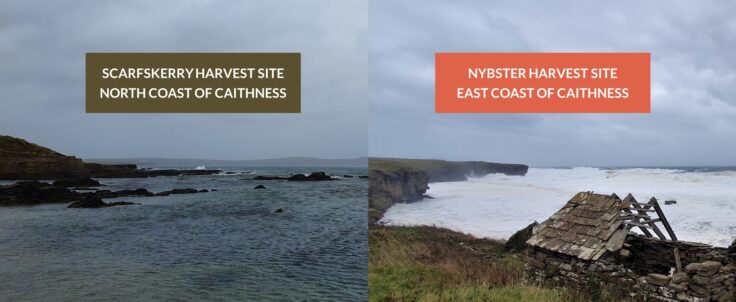
The shores of Caithness offer different harvest options, as shown in these photos taken on the same stormy day on the north and east coasts
We will review our harvest quotas to ensure there are no constraints to our plans. Surveys were completed on each harvest site before they were brought into licence in order to work out how much seaweed was present, broken down by 17 different species. See the article on our Keiss harvest site for more detail on how we work out seaweed biomass. Our harvest quota is up to 20% of the total volume for each species. There are now automated systems in place to flag sites with low quota to make sure we stay within our agreed harvest volumes.
Another element of planning is reviewing information captured during previous harvests. We have harvested thousands of batches over the years: a quick check of our production data will show us if we managed to harvest a certain variety of seaweed in the forecasted conditions and tide height. Indeed, a customer may require a species we rarely harvest: we can check our systems to see where and when we have managed to source it in the past. This information is also really important for the traceability our customers seek, especially those in food, nutraceuticals and cosmetics.
There are various options if the expected conditions prevent us from going ahead with Plan A. We might choose a harvest site on a different coast, because a storm will usually only affect one stretch of shoreline. There are a handful of sheltered sites within our licences: Brough is usually protected from prevailing wind and swell on the north coast. Sometimes we will target a different variety of seaweed, well out of reach of breaking waves.
There are a lot of variables to consider when planning seaweed harvesting. It has become slicker over the years as tides and seasons have become second nature to us.
Preparation on the day
Harvest trips may require a very early start to catch a spring tide: our earliest shifts begin at 6:00am. This is less critical for mid shore species of seaweed, because they tend to be exposed for at least five hours. One of the key points of picking wild seaweed is that each trip is only ever a half day because we are limited by tide. Generally seaweed harvested in a morning will be processed that afternoon.
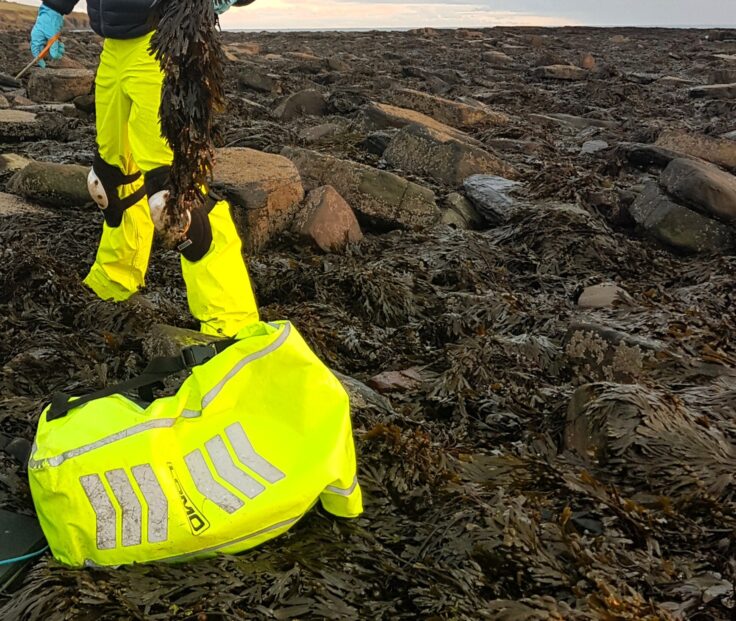
An emergency bag containing first aid kit and safety equipment comes down to the shore on every harvest.
Before leaving for a harvest, we will make sure all our equipment is ready. One of the essential items is our emergency bag. This brightly coloured drybag contains a first aid kid, a throw line and a personal locator beacon: a small waterproof gadget that can be used to alert search and rescue services even when mobile networks are down. The Royal Yachting Association website has more information on these safety devices. It is also important to check the condition of scissors and bags as any issues are difficult to resolve on the shore.
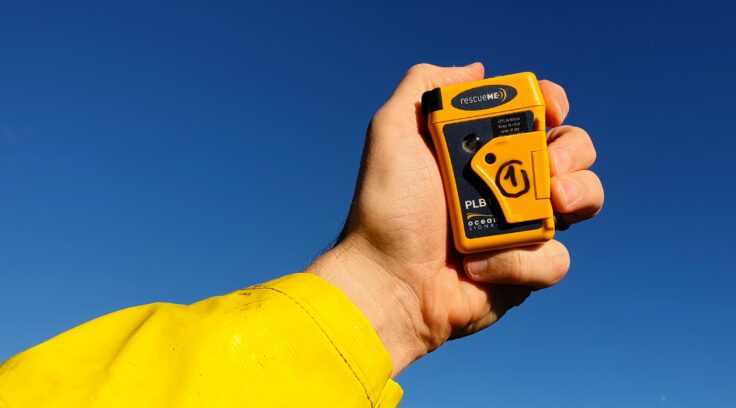
A personal locator beacon is a small waterproof device that is manually activated in an emergency to help pinpoint your location to search and rescue services
Our nearest sites are just five minutes from our factory in Wick, but most harvests require a 20-30 minute drive north. The aim is to be on the shore before low water to maximise the time available for harvesting. Also, the tide tends to rise faster than it falls and some of our gently sloping sites tend to flood quickly.
Starting the harvest
There will always be a quick sense check when we arrive to make sure that the conditions are as expected. Every so often, the water is higher than we estimated or the target species of seaweed is not as abundant as we thought. Situations like this need rapid assessment: either wait for more shore to be revealed as the tide falls, or move on to a different site. There will always be a number one priority for harvesting, but the team will usually have a secondary species to go for just in case.

Even after all the planning, our harvesters still need to make decisions according to the conditions on the shore
Before getting going, a harvest supervisor will review maps of the site to check for nearby exclusion zones. Some are in place because of known local contamination risks. For example, we keep at least 10m away from the edge of small slipways and jetties. There are also sections of shoreline reserved for ongoing monitoring projects. We will also consider local wildlife: all harvesters are trained against the principles of the Wildlife Conduct Code.
The team will spread out to avoid working the same patches, taking care to remain within sight and earshot of each other. Seaweed is always cut to allow regrowth, with the exact method varying between species. Those in the kelp family are cut above the growing tissue at the base of the frond. Wracks grow at their tips, which means they are harvested to leave parts of each plant behind for future growth.
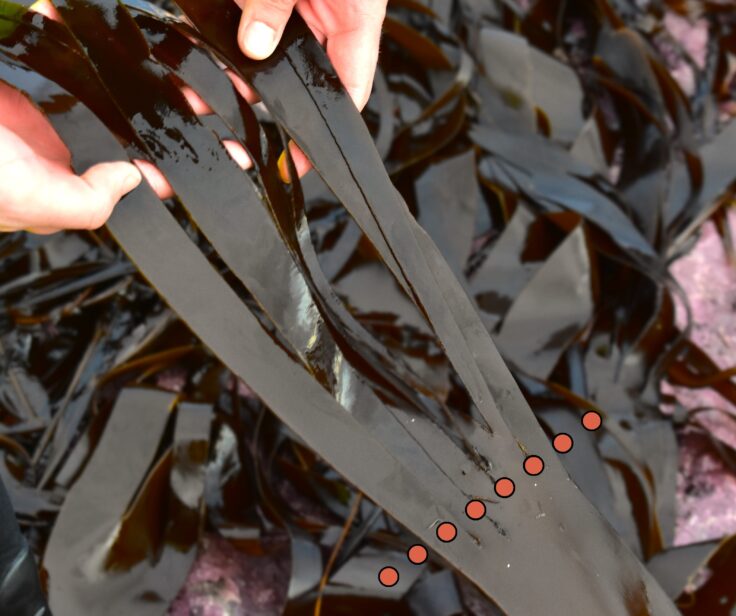
Species must be harvested to allow for regrowth: kelp is cut above the meristematic tissue at the base of the frond
Hand selection helps maximise quality. Harvest rates will vary for many reasons. Picking is slower during the shoulder seasons, either because the plants or small or it is harder to find high quality plants. Harvest supervisors need to make a call on the day if the rates have dropped, because it is probably worthwhile moving on to a different species. Bags are left on clean surfaces: bare rock on the mid shore is ideal. Each harvester will work away, leaving bags in piles at a few different spots.
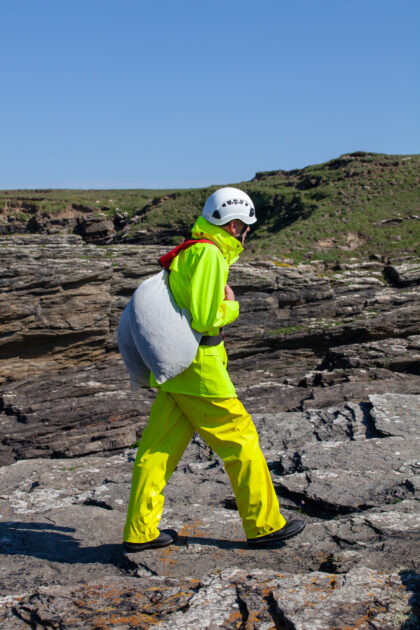
Seaweed is carried up to the top of the shore at the end of the harvest
Getting the seaweed back to base
Nature often determines the end of the harvest; the tide gets too high or the light drops too low. Most harvests stop once the target volume is reached. We never take weights on the shore as it slows everything down. Our many years of harvesting mean we know roughly how much each bag will be. Bags are carried up to the top of the shore over a few runs. This can be heavy going on some days, especially if carrying over boulders. The best sites are often those with a short flat walk back to the van. Access to the coast is an essential part of deciding if a site will be viable for seaweed harvesting. Some details are recorded in our registers for future reference, including the coordinates of the part of the shore used that day.
Arriving back at the factory in Wick, intake is a fairly quick process. Bags of seaweed are weighed on hanging scales. We have gone through a few sets over the years, but the same bracket we installed in 2016 is still going strong: 400 tonnes of seaweed and counting! All the necessary details are added to registers to ensure we have traceability for the batch. Wet gear is brought inside to dry and then team stop for lunch or head home.
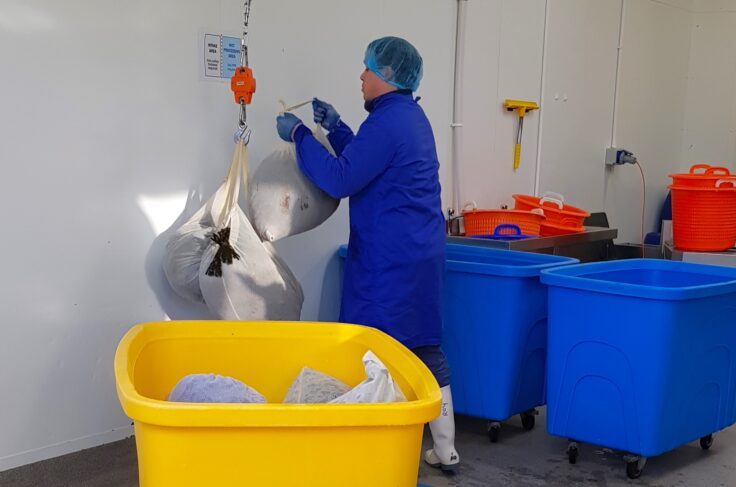
Seaweed is weighed at intake at our food-accredited facility ahead of further processing
We will make time to review the harvest and discuss plans for the next trip. This is especially important if a harvest has not gone as planned: which other site or species should we target next? Key data like intake weights and batch codes are uploaded to our systems as soon as possible to help our planning.
Teamwork makes harvesting successful
This may all seem like a lot of work for just seaweed, but it has all become second nature to our team now. We have accumulated a lot of knowledge over the years. However, we need to continuously improve our approach to ensure our harvests remain successful and sustainable. As the old adage goes: fail to prepare, prepare to fail!
